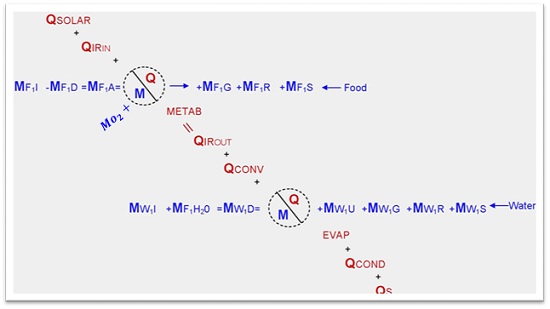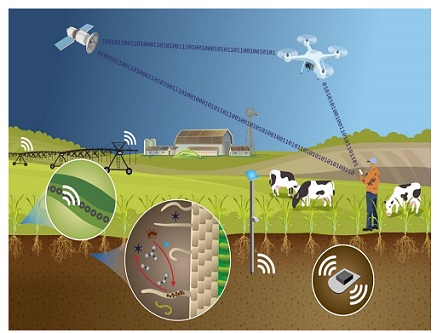
Looking to the Future in Managing a Dairy Production System: A Perspective
*Corresponding Author(s):
Kifle G GebremedhinInternational Professor Emeritus And ASABE Fellow, Department Of Biological And Environment Engineering, Cornell University, Ithaca NY 14853, United States
Email:kgg1@cornell.edu
Introduction
Future directions in the cattle industry will be driven by consumer demand for higher quality foods and production methods involving animal health and comfort in changing climates, diet quality, management practices and disease reduction. The objective of this piece is to provide a perspective on the requirements to achieve future demands.
Consumer Demand
Consumer demand is becoming more sophisticated. Large corporate chains are demanding that producers give them products that are healthier, pesticide free, hormone free, GMO free, humanely raised and environmentally sustainable in terms of improving soil quality and lower methane emissions. These strong-market share forces will continue to shape the supply markets. Producers will be continuously constrained to meet those demands. Achieving those demands for enhanced cattle health, comfort and productivity will require more sophisticated understanding of climate, diet, environmental management and disease effects on calf growth rate and milk production potential. Methods for achieving these goals are already in place or are in development.
Animal health, comfort and productivity
- Climate
Animal health, comfort and productivity are affected by climate, diet, management environment and level of disease. Global climates are warming rapidly and are becoming more and more erratic locally. Growth rates and milk production are especially sensitive to high and low temperature extremes. Correlation models to anticipate climate effects on cattle have shortcomings noted in recent reviews [1]. Recent developments in computational models that tie local climate variation to performance have recently appeared and show promise for anticipating combinations of environmental variables that would compromise milk production or growth rates [2]. The appearance of critical combinations of environmental variables can induce sudden, precipitous declines in milk production capacity or growth. Genetic selection is aiming for larger animals that will produce more milk per animal, but larger cows will be less adapted to warming climates than their smaller counterparts [3].
- Diet
Diet has important consequences for overall health and nutrition and can have profound implications for a cow’s gut microbiomes that not only are vital for milk production but have a dual role in that they can constitute approximately70% of immune function. Pesticide residues from crops have been documented as showing up in milk on a global scale. Some of these pesticides can impact gut microbes essential for milk production and may affect growth processes [4] , and most importantly, susceptibility to diseases due to lowered immune function. As global human health issues continue to escalate, consumers will be looking for healthy foods to consume. Technologies for detection of pesticide residues are rapidly evolving, which will make testing much less expensive, more rapid and more frequent. Grass fed cows are already being promoted as being pesticide free. Those trends will continue to strengthen demand and force modification of production methods.
- Environment
Management of local environments has multiple benefits, such as available shade in the form of trees or structures to reduce heat loads, water availability or access affect cow comfort and milk production capacity, timing of pregnancies can increase milk production if calves are born at times of the year when climates are optimally cool, which benefit both the mother and the calf in terms of milk production and maximum calf growth rates. Careful sanitation can affect disease bearing or nuisance insects that can compromise animal comfort, hence enhance activity levels and lower production rates. High cattle activity levels take mass and energy from production and spend it instead on activity to seek better or more comfortable local conditions, thereby impacting discretionary resources available for optimal calf growth rates and cow milk production.
- Disease
Diseases such as mastitis, ketosis and pneumonia require metabolic responses from cattle that impact their potential productivity directly and indirectly by altering activity and appetite levels that in turn affect resources available for milk production. Rapid, noninvasive diagnostics to identify cow diseases and their severity earlier are becoming available, which will affect antibiotic usage, feasible growth rates, final body size and production potential. A recent startup technology, Isomark.com, has demonstrated a patented rapid (30 – 35 second) presymptomatic (24-48 hour) detection of infection using naturally occurring stable isotopes in breath. This technology is starting to be used in robotic milking environments. This can result in subsequent cost savings due to reduced antibiotic use, enhanced milk production from healthier cows and improved calf growth rates.
Future Computational Necessities In Managing Dairy Production Systems
The current state-of-the-art approach to modeling animal bioenergetics and environmental control is based on predicting heat fluxes and/or internal body temperature of the animal. Heat fluxes or internal body temperature are calculated from fundamental principles of coupled heat and mass transfer (Figure 1) through the skin and the haircoat. This approach is limited in scope and cannot account for all the independent variables that affect animal comfort, production and reproduction potential. The animal-environment-control system is so complex that it warrants a big-data approach to analyze and make management decisions. Because of the complexity of the system, which includes physiological, morphological, behavioral, metabolic, productive, and immunological responses, and the need for producers to have real-time monitoring decision-making provisions (Figure 2), new approaches and tools will be necessary. The possibility of collecting a large dataset made available by the number of sensors used for daily livestock monitoring is paving the way for the application of advanced and robust numerical techniques based on machine learning (ML) or big data approaches and AI algorithms [5,6].
 Figure 1: Coupled heat and mass transfer equations for irradiated haircoat. (From Gebremedhin et.al. 1984).
Figure 1: Coupled heat and mass transfer equations for irradiated haircoat. (From Gebremedhin et.al. 1984).
Key:
Q: Heat
M: Mass
Subscripts:
F: Food
I: Ingested
D: Defecated
A: Absorbed
U: Urine
G: Growth
R: Reproduction
W: Water
S: Stored
IR: Infrared Radiation
METAB: Metabolism
CONV: Convection
COND: Conduction
EVAP: Total Evaporation
 Figure 2: Real time continuous system monitoring (soil, crop, water, and livestock) via sensors. (From National Academies Press, Science Breakthroughs to Advance Food and Agricultural Research by 2030).
Figure 2: Real time continuous system monitoring (soil, crop, water, and livestock) via sensors. (From National Academies Press, Science Breakthroughs to Advance Food and Agricultural Research by 2030).
Conclusion
It can be concluded that, in the years to come, the key elements for the dairy sector would be increasing sustainability and at the same time, ensure animal health and wellbeing, increase milk quantity and quality, improve reproductive performance, improve efficiency of resources, and reduce gaseous emissions, and these objectives are possible to accomplish through real-time monitoring of the entire system and performing wholistic analyses.
References
- Neves SF, Silva MCF, Miranda JM, Stilwell G, Cortez PP (2022) Predictive Models of Dairy Cow Thermal State: A Review from a Technological Perspective. Vet Sci 9.
- Porter WP, Bertz AE, Mathewson PD, Solorzano LC, Dudley PN, et al. (2023) Climate Spaces and Cliffs: A Novel Bovine Thermodynamic and Mass Balances Model. Animals 13: 3043.
- Liu J, Li , Chen X, Lu Y, Wang D (2019) Effects of heat stress on body temperature, milk production, and reproduction in dairy cows: a novel idea for monitoring and evaluation of heat stress- A review. Asian-Australas J Anim Sci 32:1332-1339.
- Boudebbouz AS, Boudalia MI, Boussadia Y, Gueroui S, Habila A , et al. (2022) Pesticide residues levels in raw cow's milk and health risk assessment across the globe: A systematic review. Environmental Advances 9:100266.
- Gebremedhin KG, WP Porter, Warner RG (1984) Heat flow through pelage of calves-a sensitivity analysis. Transactions of ASAE 27: 1140-1143 and 1149.
- National Academies Press (2019) Science breakthroughs to advances food and agricultural research by 2030.
Citation: Porter WP , Gebremedhin KG (2023) Looking to the Future in Managing a Dairy Production System: A Perspective. J Anim Res Vet Sci 7: 057.
Copyright: © 2023 Warren P Porter, et al. This is an open-access article distributed under the terms of the Creative Commons Attribution License, which permits unrestricted use, distribution, and reproduction in any medium, provided the original author and source are credited.

